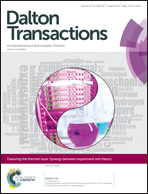Double exchange in a mixed-valent octanuclear iron cluster, [Fe8(μ4-O)4(μ-4-Cl-pz)12Cl4]−†
Abstract
A combination of SQUID and pulsed high-field magnetometry is used to probe the nature of mixed valency in an FeIIFe7III cluster. DFT-computed spin Hamiltonian parameters suggest that antiferromagnetic coupling dominates, and that electron transfer both between the four irons of the cubane core (t1) and between a cubane and three neighboring irons (t2) is significant. Simulations using the computed parameters are able to reproduce the key features of the measured effective magnetic moment, μeff(T), over the 2 < T < 300 K temperature range. In contrast, the field dependence of the molar magnetization, Mmol, measured at 0.4 K is inconsistent with substantial electron transfer: only values of t2 ∼ 0 place the separation between ground and first excited states in the region indicated by experiment. The apparent quenching of the cubane–outer electron transfer at very low temperatures indicates that vibronic coupling generates one or more shallow minima on the adiabatic potential energy surfaces that serve to trap the itinerant electron in the cubane core.
![Graphical abstract: Double exchange in a mixed-valent octanuclear iron cluster, [Fe8(μ4-O)4(μ-4-Cl-pz)12Cl4]−](/en/Image/Get?imageInfo.ImageType=GA&imageInfo.ImageIdentifier.ManuscriptID=C4DT00020J&imageInfo.ImageIdentifier.Year=2014)
- This article is part of the themed collection: Synergy between Experiment and Theory

 Please wait while we load your content...
Please wait while we load your content...